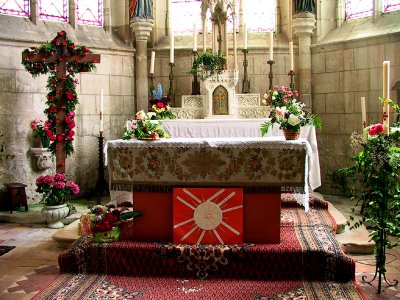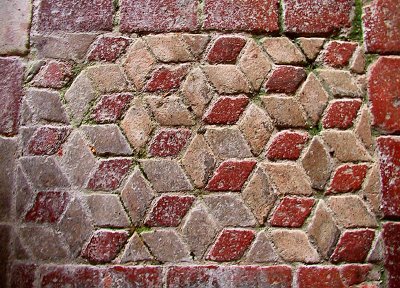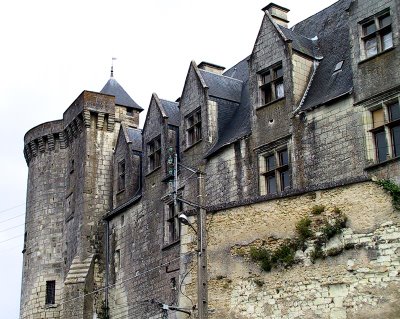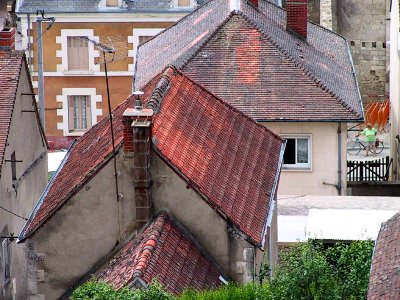 The elaborate decorations and flowers around the altar
The elaborate decorations and flowers around the altarmakes it seem the church is the center of village life.
Five of the ten photos of stained-glass windows I posted yesterday were ones I took in the Palluau church. There was of course other artwork in the building, including polychrome stone statuary from the 15th and 16th centuries and numerous paintings.
But as usual in these small French towns, you have to look up, down, and sideways to see the small details that a quick glance won't reveal. Here, for example, are two patterns I noticed in the 15th-century tilework on the floors in a side chapel of the church.
The church is actually named for Saint-Sulpice and was originally built in the 12th century, replacing an older church named for Sainte-Menehould. Work on the Saint-Sulpice church continued off and on until the 16th century.
When I said that the gothic-style château was just above us on a promotory, this is what I meant. It really dominates the upper town, including the church. It isn't open to the public now, but the people at the tourist office said it would probably be open for tours in July and August.
The massive towers of the château date from the 12th century and were part of the building's defenses. The newer parts, built in the 13th century, are residential.
Another thing Palluau has that make it typical is an unexpected history. I mentioned it yesterday: the comte de Palluau was Louis de Frontenac, one of the governors of the province of Québec in the New World.
Palluau also has a monument we didn't get to see on Wednesday, because of the street paving work in progress. It's an old monastic building, a priory, that features romanesque frescoes showing religious scenes, including one of Mary wearing a crown and sitting on a throne with arms that are dragons' heads. We've got to return to see that.
Because it is on a promontory above a river valley, there are also great views from upper Palluau. That is also typical of so many little French towns.
The village is modernizing now. The 21st century is upon us, and villages all over our region are putting in new sewer systems, building road bypasses, and tearing up old streets and repaving them. Broad-band Internet access is widely available (I have it in the country outside Saint-Aignan).
At the same time, Palluau is picturesque despite the modernization now taking place. A walk through the old streets reveals those typical old French windows and doors that often need a fresh coat of paint. Old buildings are for sale or have recently been sold, and are being freshened up. There are flowers everywhere right now. It's the season.
I'm glad I saw Palluau this week. The place is changing, and it will be interesting to see how it turns out. Of course, plus ça change, plus c'est la même chose, as we say in French. The village has existed for a thousand years, or maybe two thousand, so it's not likely to lose its identity and character in my lifetime. I'm looking forward to going back.











Lovely! Thanks for the tour.
ReplyDeleteChrisP
Sympa, le compte-rendu de tes impressions sur ce joli village. Le pavage de l'église est très, très beau, moi, j'y ai vu des cubes...
ReplyDeleteQue penses-tu d'inclure une mini carte pour nous aider à situer les endroits que tu nous décris si bien ? Bises. Marie qui commence ses corrections de bac et qui t'est reconnaissante pour l'agréable détente donnée par la lecture de ton blog et la contemplation des photos qui sont toujours si chouettes :-)